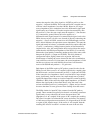
Chapter 2 Configuration and Installation
©
National Instruments Corporation 2-33 AT-MIO-16X User Manual
Caution: Under no circumstances should these +5-V power pins be directly
connected to analog or digital ground or to any other voltage source on the
AT-MIO-16X or any other device. Doing so can damage the AT-MIO-16X
and the PC. National Instruments is not liable for damages resulting from
such a connection.
Timing Connections for Data Acquisition and Analog Output
The data acquisition and analog output timing signals are SCANCLK,
EXTSTROBE*, EXTCONV*, EXTTRIG*, EXTGATE*, and
EXTTMRTRIG*.
SCANCLK Signal
SCANCLK is an output signal that generates a low-to-high edge
whenever an A/D conversion begins. SCANCLK pulses only when
scanning is enabled on the AT-MIO-16X. SCANCLK is normally
low and pulses high for approximately 8 conversion begins. The
low-to-high edge can be used to clock external analog input
multiplexers. The SCANCLK signal is driven by one CMOS TTL gate.
EXTSTROBE* Signal
A low pulse of no less than 500 ns is generated on the EXTSTROBE*
pin when the External Strobe Register is accessed. See the External
Strobe Register section in Chapter 4, Register Map and Descriptions,
for more information. Figure 2-13 shows the timing for the
EXTSTROBE* signal.
Figure 2-13.
EXTSTROBE* Signal Timing
The pulse width is defined as 500 ns minimum. The EXTSTROBE*
signal can be used by an external device to latch signals or trigger
events. The EXTSTROBE* signal is an HCT signal.
t
w
500 nsec
V
OH
t
w
V
OL
-


















